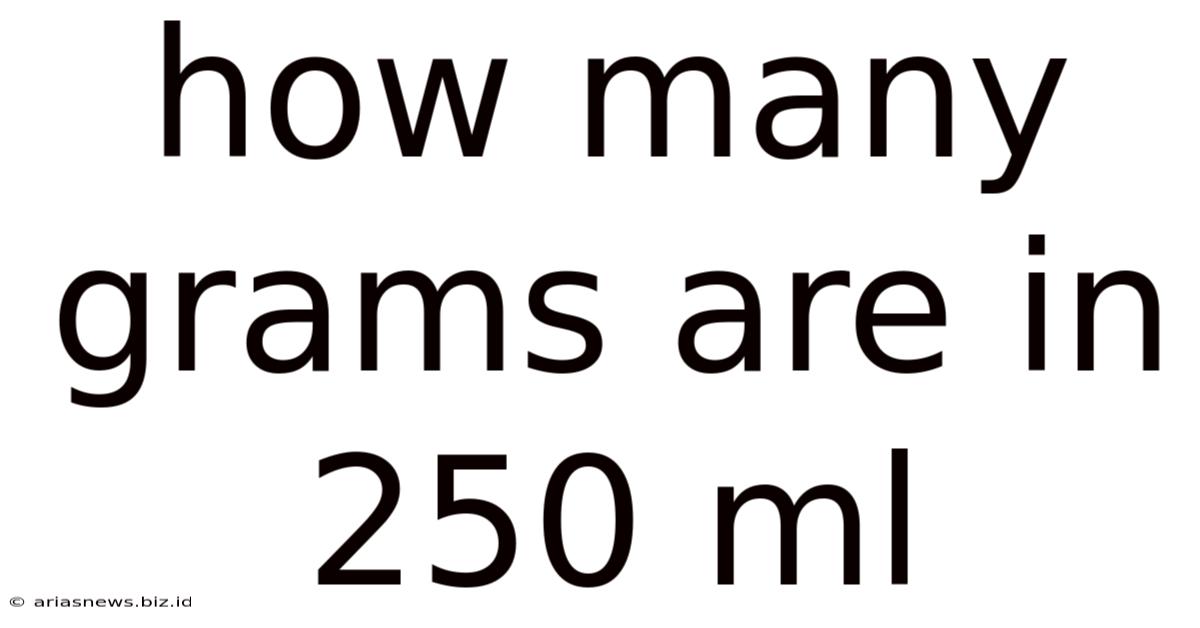How Many Grams Are In 250 Ml
Arias News
May 09, 2025 · 4 min read

Table of Contents
How Many Grams are in 250 ml? Understanding Volume, Mass, and Density
The question "How many grams are in 250 ml?" doesn't have a single, simple answer. This is because the relationship between milliliters (ml), a unit of volume, and grams (g), a unit of mass, depends entirely on the density of the substance being measured. Density is a measure of how much mass is packed into a given volume. Water, for example, has a different density than oil, which has a different density than mercury.
This article will delve into the complexities of this conversion, providing you with the tools to accurately calculate the mass of a 250 ml volume for various substances. We'll cover the fundamentals of density, explore common substances and their densities, and provide practical examples to help you understand this important concept.
Understanding the Relationship Between Volume and Mass
Before we tackle the specific question, let's establish the core principle: volume refers to the amount of three-dimensional space a substance occupies, while mass refers to the amount of matter it contains. They are related through density, which is defined as:
Density = Mass / Volume
This formula can be rearranged to solve for mass:
Mass = Density x Volume
And for volume:
Volume = Mass / Density
Therefore, to determine the mass (in grams) of a 250 ml volume, we need to know the density of the substance.
The Special Case of Water
Water is often used as a benchmark because, under standard conditions (4°C and 1 atm pressure), it has a density of approximately 1 g/ml. This means that 1 milliliter of water has a mass of approximately 1 gram.
Therefore, for water:
- Mass = Density x Volume
- Mass = 1 g/ml x 250 ml
- Mass ≈ 250 g
So, 250 ml of water weighs approximately 250 grams. It's important to remember that this is an approximation, and the exact density of water can vary slightly depending on temperature and pressure.
Density of Common Substances
The density of different substances varies greatly. Here's a table listing the approximate densities of some common substances:
| Substance | Density (g/ml) |
|---|---|
| Water (4°C) | 1.00 |
| Milk | 1.03 |
| Seawater | 1.025 |
| Olive Oil | 0.92 |
| Vegetable Oil | 0.91 - 0.93 |
| Gasoline | 0.71 - 0.77 |
| Mercury | 13.6 |
| Ethanol (Alcohol) | 0.79 |
| Honey | 1.42 |
| Aluminum | 2.70 |
This table highlights the significant difference in density among different materials. A 250 ml volume of mercury would weigh considerably more than the same volume of gasoline.
Calculating Mass for Different Substances
Let's calculate the mass of 250 ml of a few substances using the formula: Mass = Density x Volume
Example 1: Olive Oil
- Density of Olive Oil ≈ 0.92 g/ml
- Volume = 250 ml
- Mass = 0.92 g/ml x 250 ml
- Mass ≈ 230 g
Example 2: Mercury
- Density of Mercury ≈ 13.6 g/ml
- Volume = 250 ml
- Mass = 13.6 g/ml x 250 ml
- Mass ≈ 3400 g (or 3.4 kg)
Example 3: Gasoline
Let's use the lower end of the density range for gasoline (0.71 g/ml).
- Density of Gasoline ≈ 0.71 g/ml
- Volume = 250 ml
- Mass = 0.71 g/ml x 250 ml
- Mass ≈ 177.5 g
These examples illustrate how crucial it is to know the density of the substance to accurately determine its mass.
Factors Affecting Density
Several factors influence the density of a substance:
- Temperature: Density usually decreases as temperature increases (exceptions exist). This is because increased temperature often leads to expansion in volume.
- Pressure: Increased pressure generally increases density by compressing the substance.
- Composition: The chemical makeup of a substance heavily influences its density. Pure substances have defined densities, while mixtures can have variable densities depending on their composition.
Practical Applications
Understanding the relationship between volume, mass, and density has numerous practical applications across various fields:
- Chemistry: Density is crucial for stoichiometric calculations and identifying substances.
- Physics: Density is a fundamental property used in various calculations involving buoyancy, pressure, and fluid mechanics.
- Engineering: Engineers consider density when designing structures, selecting materials, and performing fluid dynamics analyses.
- Food Science: Density is relevant in determining the concentration of solutions, determining the weight of ingredients and calculating nutritional values.
Conclusion: The Importance of Context
The answer to "How many grams are in 250 ml?" is inextricably linked to the density of the material being measured. While 250 ml of water is approximately 250 grams, this is not true for other substances. Always consider the density of the specific material when converting between volume and mass. Using the formula Mass = Density x Volume, along with a reliable density value for your substance of interest, allows for precise calculations. This understanding is crucial in many scientific, engineering, and everyday applications. Remember to consider factors like temperature and pressure that can influence density and always use appropriate units for accurate results.
Latest Posts
Latest Posts
-
How Many Ounces In A 3 Pounds
May 09, 2025
-
12 Oz Of Pasta Is How Many Cups
May 09, 2025
-
What Does Three Dots In A Triangle Mean
May 09, 2025
-
How Do You Dry Hump A Pillow
May 09, 2025
-
Can A Triangle Be Isosceles And Right
May 09, 2025
Related Post
Thank you for visiting our website which covers about How Many Grams Are In 250 Ml . We hope the information provided has been useful to you. Feel free to contact us if you have any questions or need further assistance. See you next time and don't miss to bookmark.